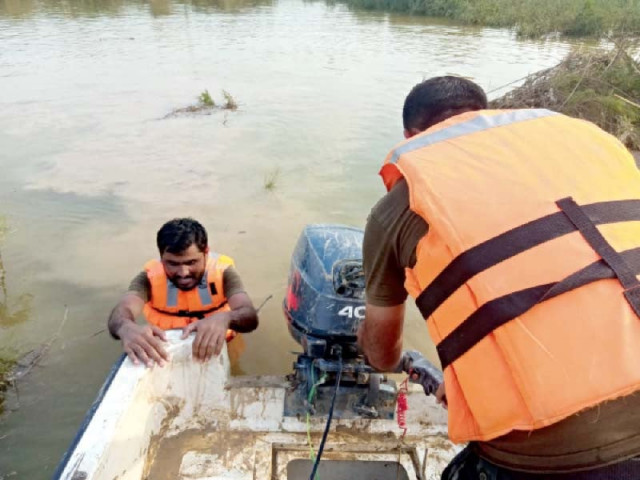With much of the farmland now under water, farmers face increased production costs, lower yields
Rescue workers continue search operations in Dera Ghazi Khan. About 120 of them participate in relief work during monsoon rains and floods. Photo: Express
LAHORE:
Punjab’s fertile farmlands, once abundant with the golden scent of ripe crops, are now a scene of devastation following recent floods.
According to the Punjab Disaster Management Authority (PDMA), over 1.441 million hectares of agricultural land in 27 districts of the province have been affected. Heavy losses have been reported in Rajanpur, Dera Ghazi Khan, Muzaffargarh, Layyah, Bahawalpur, Chiniot, Kasur, Okara, Mandi Bahauddin, Sialkot and Narowal where crops like rice, cotton, sugarcane and vegetables have been completely destroyed.
Experts claim that the floods have washed away the topsoil, damaging its structure, nutrients and salinity balance. Former Director General of Agriculture Punjab, Dr. Anjum Ali Butter, explained that flood water deposits salts in the soil which hinder root growth. “The use of organic fertilizers and the cultivation of pulses are now required to restore soil fertility,” urged Dr. Butter.
Progressive farmer Aamir Hayat Bhandara revealed that earlier one bag of DAP fertilizer was enough for a crop, but now three or four may be needed, increasing production costs considerably. “The government needs to conduct meso-level soil tests to design area-specific restoration strategies,” suggested Bhandara.
In several flood-affected areas, thick layers of mud and sand have settled over the land. Farmers complain that removing these deposits is expensive and technically challenging. One such farmer, Rana Mubashir Hassan, estimated that restoring a single hectare could cost between Rs50,000 to Rs100,000, an amount that is unaffordable for small farmers.
In Sharaqpur, another farmer, Chaudhry Muhammad Yaqoob’s 15-hectare guava plantation was completely destroyed. “I had invested about Rs1.5 million and I am now facing a loss of Rs3.5 to Rs4 million,” lamented Yaqoob. Similarly, a Kasur-based farmer Mehr Javed reported that low-lying areas were still waterlogged, delaying sowing for Rabi season vegetables.
According to an initial report by the Crop Reporting Service, 51,000 acres out of Punjab’s 115,000 acres of land growing vegetables have been damaged, with Lahore, Sahiwal and Faisalabad divisions being the worst affected. The vegetable supply districts of Kasur and Sheikhupura, which cater to Lahore, have also suffered extensive losses. Several villages along the river Ravi in Sharaqpur remain inundated.
In southern Punjab, mango plantations and in the Lahore division, guava farms were particularly hard hit. A total of 71,467 acres of orchards have been affected across Punjab, including 64,480 acres of mango trees. In Multan division alone, 38,355 hectares of mango plantations went under water. According to Dr. Stagnant water accelerates the spread of fungi and bacteria that damage tree roots, requiring five to eight years for complete recovery.
Agricultural experts estimate that full soil rehabilitation could take two to three years. Many even suggest the use of gypsum, potassium and sulfate fertilizers along with green manure crops such as mung beans or berseem to help restore fertility.
However, the farmers believe that the government’s financial assistance is insufficient. Rana Mubashir Hassan pointed out that the announced subsidy of Rs 20,000 per hectare was insufficient and could not even cover the cost of clearing the land, let alone replanting it.
On the other hand, experts attribute the destruction to climate change and poor water management. This year’s rainfall intensity was 50 percent higher than normal, and weaknesses in the canal system, combined with the sudden release of water from upstream dams, worsened the situation.
According to a UN report, about 2.2 million hectares of land in Pakistan remain under water, posing a serious threat to future food security.



